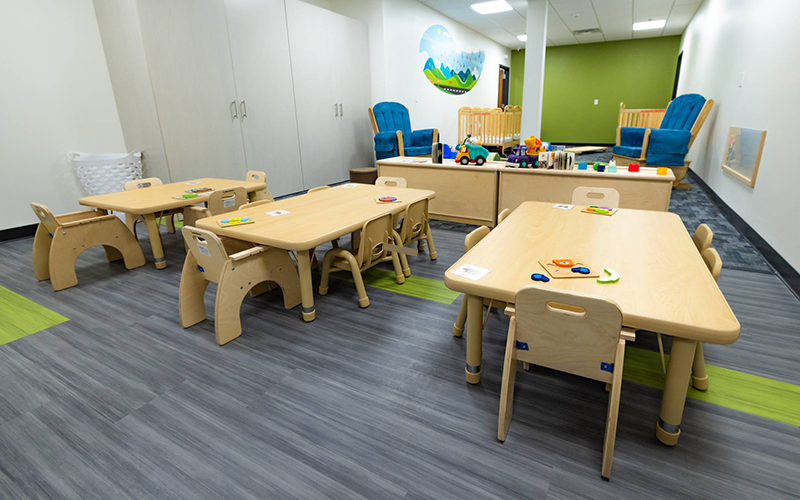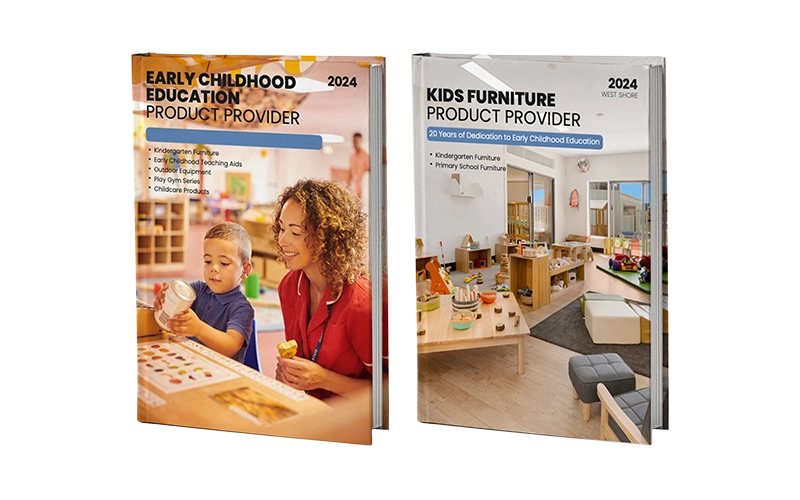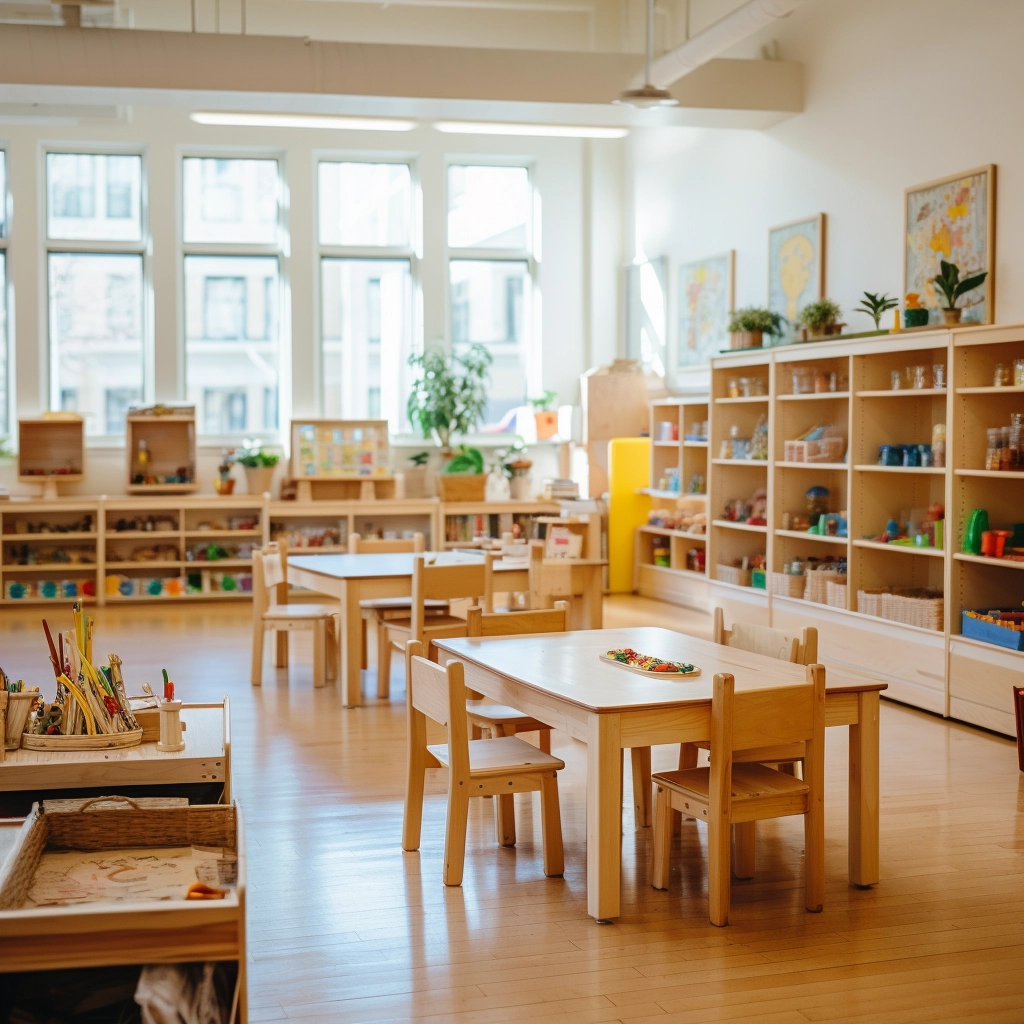Premium Preschool Tables and Chairs for Early Learning Environment
We offer a range of daycare tables and chairs designed to create a creative and engaging learning environment for children. We focus on customizable furniture to meet the unique needs of your ideal early education environment. These durable tables and chairs combine safety, comfort and style to enhance any classroom layout. You can choose to suit your kindergarten's style and budget to create a safe and comfortable space for learning and playing.

A Wide Selection of Preschool Tables and Chairs
We offer a range of professional daycare tables and chairs to suit a variety of educational activities and classroom designs. We have tables, including round, square, rectangular, and a variety of design styles, to suit any room layout; and chairs in a variety of heights and sizes to suit a variety of kindergarten learning needs. We offer a wide range of color and material options to suit a variety of kindergarten decoration designs. Equip your educational institution with our specially designed furniture to create a safe and fun learning environment.

Adjustable Toddler Table

Rectangle Table

Half Circle Table

Circular Table

Bentwood Cube Table Set

Feeding Chair Set

Daycare Butterfly Table and Chair Set

Daycare Play Area Sofa Set

Wall Bench

Chair

Toddler Stacking Chair

Bent Chairs

Low Wood Feeding Chair

Toddler Couch and Chair

Activity Table

Folding Storage Table
Manufacturing and Supplier for Premium Preschool Tables and Chairs - Westshore Furniture
Trusted by numerous preschools for classroom furniture needs. Crafted to enhance learning environments with outstanding quality and durability. Safe, sturdy, and aesthetically pleasing furniture solutions are designed for the dynamic needs of young learners. Each piece ensures children’s comfort and educational engagement. Furniture that makes a difference in early education.
Quality Materials
We offer a variety of high-quality materials for our preschool furniture, ensuring durability, safety, and aesthetic appeal. Our selection includes:
-
OAK Renowned for its strength and durability, oak features a prominent grain that resists wear, ideal for busy classrooms.
-
Maple Known for its dense, strong composition and smooth, fine grain, maple offers a clean, modern aesthetic.
-
Birch Chosen for its fine texture and appealing light color, birch ensures durability with a sleek finish.
-
Pine With its warm, rustic look, pine is lightweight and perfect for creating an inviting atmosphere.
-
Rubberwood Valued for its durability and eco-friendliness, rubberwood is a solid choice for sustainable furniture.
-
Beech Durable and aesthetically versatile, beech is excellent for furniture that withstands extensive use.
-
Particleboard Cost-effective and ideal for achieving a flat, smooth surface, perfect for laminate finishes.
-
Plywood Combines strength with a smooth finish, making it a top choice for high-quality preschool furniture.
-
Birch Plywood Combines strength with a smooth finish, making it a top choice for high-quality preschool furniture.
-
MDF Offers a smooth surface for painted finishes and is highly resistant to warping.
-
HDPE/PP These materials are lightweight, easy to clean, and perfect for creating colorful, fun furniture that is safe for children.
-
Metal Adds strength to furniture, used in structural components to enhance durability.
What are the Features of Kindergarten Classroom Tables and Chairs?
Kindergarten classrooms require furniture that combines functionality, comfort, and safety for young learners. Preschool tables and chairs are designed with these essential features in mind:
Durability
Furniture for young children needs to withstand heavy daily use. Materials like solid wood, plastic, and metal are chosen for their robustness, ensuring the preschool tables and chairs hold up under constant wear and tear.
Comfort and Ergonomics
Preschool chairs and tables should be ergonomically designed to support young children’s posture. Preschool chairs often feature contoured backrests and appropriate seat heights to ensure comfort during learning and play.
Safety Features
Rounded edges, non-toxic finishes, and sturdy constructions are crucial to prevent accidents. Preschool classroom tables and chairs are built with safety as a top priority, minimizing the risk of injury in a busy classroom setting.
Customization Options
To better integrate the brand characteristics of each kindergarten, we offer customized options including size, color, and design, as well as printing the school logo directly on the furniture.
Tips for Choosing Preschool Table & Chairs
Functionality and Age
When selecting preschool tables and chairs, it’s essential to consider their primary use. As children grow, adjustable and versatile furniture will accommodate their changing needs. This ensures that the preschool tables and chairs remain suitable for various activities like arts, crafts, and learning.
Maximize Your Space
If space is limited, select compact preschool tables and chairs. Consider stackable chairs and tables that fit together easily, or opt for smaller, round designs that can be positioned in corners to maximize floor space. This approach keeps the classroom organized.
Choose Durable Materials
Preschool tables and chairs should be made from durable materials that can withstand daily use. While colorful plastic options may be tempting, they often don't last as long as solid wood. High-quality preschool tables and chairs that will grow with your child's play, learning, and activities.
Aesthetic and Design
Look for preschool tables and chairs that complement the aesthetic of the space. Choose designs that appeal to young learners while being versatile enough to accommodate changing interests over time. Simple and modern designs in neutral colors ensure that the furniture remains stylish through various phases of your child's growth.
Safety First
When shopping for preschool tables and chairs, prioritize safety. Choose furniture with rounded edges, non-toxic finishes, and sturdy construction to ensure it won’t tip over easily. The preschool tables and chairs should also be age-appropriate in size and design, providing comfort and preventing accidents during use.
Different Types of Classroom Table and Chairs
When creating an effective and engaging learning environment for preschoolers, choosing the right preschool tables and chairs is essential. From versatile options like adjustable tables to space-saving folding designs, each type of table and chair is designed with specific functions in mind. Below, we’ll explore some of the most popular categories of preschool tables and chairs to help you choose your educational space.

Standard Tables and Chairs

Activity Tables

Folding Tables

Combination Units

Group Tables

Adjustable Tables and Chairs
Preschool Table and Chair Size Chart
Selecting appropriately sized furniture is essential for children’s comfort and safety. Here’s a quick reference for children's tables and chairs for daycare or preschool:

Customization Options for Classroom Tables and Chairs
No matter if you're outfitting a daycare, nursery, preschool, or kindergarten, you can customize the perfect tables and chairs to meet your specific needs. Personalizing classroom furniture enhances both the functionality and aesthetics of the learning space. Customization options include:
Color and Design
Choose from various colors and designs to match the classroom’s theme. Bright colors or fun patterns can make the learning space more inviting and engaging for children.
Material Customization
Select from durable materials such as wood, plastic, or metal based on classroom needs. You can choose materials that are easy to clean, durable, and safe for children.
Size Adjustments
Many manufacturers offer customizable sizes for tables and chairs to ensure they fit in your classroom layout, providing comfort and functionality for children.
Preschool Table and Chair Arrangement Tips
The arrangement of preschool tables and chairs significantly affects the classroom environment. Consider these tips when organizing seating:

Traditional
Tables and chairs are lined up facing the teacher. Suitable for structured lessons but limits student interaction.

Roundtable
Children and teachers sit around a central table. Promotes open communication and group discussion.

Horseshoe or Semicircle
Seats are arranged in a U-shape. Encourages group discussion and teacher movement for interaction.

Double Horseshoe
Two U-shaped rows, allowing larger group discussions. Foster peer communication.

Pods (Groups, Pairs)
Tables are grouped for small teams (3–4 students) or pairs. Ideal for cooperative learning and group activities.
Safety Considerations for Preschool Tables and Chairs
We understand that safety is a top priority when it comes to preschool tables and chairs. That's why we carefully design and craft our products with your child's safety in mind. Here are some essential safety features we focus on:
Rounded Edges
Choose preschool furniture with smooth, rounded edges to prevent injuries from sharp corners and create a safer, more welcoming classroom environment.
Non-toxic Materials
Ensure that preschool tables and chairs are made from non-toxic materials, such as BPA-free plastic and lead-free paints, to guarantee the safety of young children.
Stability
Select sturdy, well-constructed furniture that won't easily tip over during classroom activities. Stable tables and chairs help prevent accidents and provide children with a safe space.
How to Maintain and Clean Preschool Tables and Chairs?
Maintaining and cleaning kindergarten tables and chairs is essential for ensuring the furniture remains in good condition and for promoting a hygienic learning environment. Here are some care tips:
-
Regular Cleaning Wipe down preschool tables and chairs after each use, especially if the furniture is exposed to art supplies, food, or other messy materials.
-
Use Non-Toxic Cleaners Always use child-safe, non-toxic cleaners when wiping down surfaces to ensure safety.
-
Inspect for Wear and Tear Regularly check for loose screws, chipped paint, or worn-out surfaces. Quick repairs can extend the life of your furniture.
-
Deep Clean Periodically Periodically, deep clean the entire classroom’s furniture by disinfecting all surfaces, ensuring the environment remains safe and sanitary for children.
FAQ
What is the ideal size for preschool tables and chairs?
The ideal size allows children to sit comfortably with their feet flat on the floor and their arms at a 90-degree angle to the tabletop.Preschool table heights should typically range between 18 and 22 inches.
Why is child-sized furniture important?
Child-sized furniture promotes proper posture and comfort, supporting children's physical development and focus during learning.
Which type of furniture is best for a preschool learning environment?
Furniture that is sturdy, ergonomic, and flexible, like adjustable tables and chairs, works best for creating an engaging and safe learning space.
What age should toddlers have tables and chairs?
Tables and chairs are ideal for toddlers starting around 18 months to 2 years old when they begin to engage in more structured activities.
How do you choose a toddler table?
Choose a table that suits their size, with rounded edges and sturdy construction for safety and comfort.
Why are tables and chairs important in the classroom?
They provide a stable, comfortable space for children to engage in activities and learning, helping to enhance focus and development.
How do you arrange tables and chairs?
Arrange tables and chairs to promote interaction, easy movement, and clear sightlines for both the teacher and the children.
What is the most practical seating arrangement for a classroom?
A flexible layout with both group seating for collaboration and individual spaces for focused work offers the best balance for preschool classrooms.




